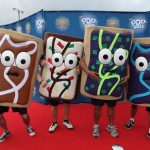The History Of The Kellogg's Breakfast Pastry Miracle: Pop-Tarts

There is something incredibly strange about Pop-Tarts. They're packaged like space food, they're more dessert than breakfast (and, I would argue, more chemical than whole ingredient) and yet, they're so. freaking. good.
S'mores is the best flavor. Don't let anyone tell you different.
There is something so quintessentially American about Pop-Tarts. When Kellogg, the creator of the beloved pastry, released Pop-Tarts in the UK in 1990, sales never exploded to the level that America had reached. Why were we so enamored by it?
Let's go back to 1963. Kellogg was experiencing overwhelming success in the cereal market: Fruit Loops were gracing shelves as a bright, colorful addition to breakfast, along with Mini-Wheats and Apple Jacks. Cereal had (and still does have) its merits: it can stay on shelves without spoiling for months on end. Post, Kellogg's main competitor, hadn't struck the same cereal-gold (we know them nowadays for Fruity Pebbles). But, they had something that would make them breakfast king over Kellogg: they found a way to keep fruit filling fresh without a refrigerator.
Post was about to revolutionize the way families had breakfast. Moms could send their kids off to school with handheld pastries full of fruit filling. Translation: a quick and healthy breakfast for the children. Think of all the time they could save, how much more efficient the family unit could be!
But Post spoke too soon. They announced their foodie invention before their product hit the shelves. What at first had been a sure-fire win for Post now turned into a business opportunity for its competitors.
Thus, the Kellogg Pop-Tart was born. With characters like Bugs Bunny, Yogi Bear and Woody Woodpecker gracing its cereal boxes, Kellogg had an "in" with kids. And they had the scoop on something big. In six months, Kellogg unveiled a new pastry that they insisted be put in the baking aisle, far away from the cereal aisle. They called it the Pop-Tart, a tip-of-the-hat to the Pop Art movement started by Andy Warhol and his neon cans of Campbell's Soup.
The original fab four Pop-Tarts flavors were modest: strawberry, blueberry, apple-currant (a flavor that would later be changed to apple-berry, as no one could really describe what the hell a currant was) and brown sugar cinnamon (a close second, in my mind, to s'mores). I think we would recoil at these originals: they were unfrosted and...well...relatively healthy. There was a scientific reason to explain this blasphemy: frosting melted off the pastries when put in the toaster. It would take another three years for Kellogg to create a frosted Pop-Tart that wouldn't pose a fire hazard when a kid tried to warm it up.
(The Pop-Tart-toaster relationship would prove to be a hot topic in years to come. In 1994, Patrick Michaud, a professor at Texas A&M, would show that Strawberry Toasted Pop-Tarts proved to be incredibly dangerous. Left in the toaster too long, they would flare up into foot-high flames.)
Kellogg's competitors tried to match the Pop-Tarts smash hit, but never could quite get there. It took General Mills eighteen years to introduce the Toaster Strudel. But unlike the Pop-Tart, the Toaster Strudel needs to be frozen before dropping it into the toaster. (Though, to be fair, I haven't heard of any toaster fires from Toaster Strudels.)
Since 1967, Kellogg has released 29 different frosted flavors of Pop-Tarts. Some, like Chocolate Chip Cookie Dough, sound like a natural dessert-y transition for a pastry to make. Others, like Salt Water Taffy, do not.
And there are bakeries doing their own, homemade versions of Pop-Tarts. But they're not the same. While homemade Pop-Tarts are buttery and flaky like a pie crust, original Pop-Tarts insist on staying bland and crumbly like a shortbread cookie. And yet, we love them anyways.
The post The History of the Kellogg's Breakfast Pastry Miracle: Pop-Tarts originally appeared on Spoon University. Please visit Spoon University to see more posts like this one.